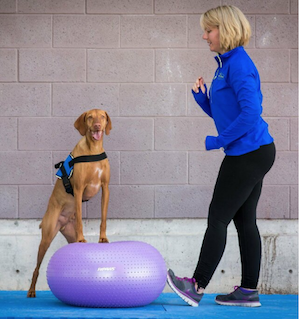Improving CORE strength can reduce the risk of ligament injuries in agility dogs.
Balance exercises may help reduce instances of cranial cruciate ligament rupture (CCLR) in canines
-
According to a recent survey conducted by Washington State University (WSU) College of Veterinary Medicine, exploring the relationship between agility dog exercise and instances of cranial cruciate ligament rupture (CCLR), the canine equivalent of an anterior cruciate ligament (ACL) tear in humans.
-
The study, which documented the activity and injury odds of more than 1,200 canines, found having strong core muscles appeared to lower the risk of CCLR. Additionally, dogs that participated in certain activities, such as dock diving and scent work, also appeared to have decreased rate of ligament rupture. Conversely, agility dogs engaged in certain other physical activities were found to have increased risk, with those that played flyball nearly twice as likely to rupture the ligament compared to other dogs. Meanwhile, regular activity (i.e. swimming, playing fetch, walking, running) did not appear to increase the risk of injury, nor lower the odds.

What is the CORE?
-
The core muscles consist of the large postural muscles of the stomach, spine, and limbs. These core muscles are the literal CORE of the body. In dogs, core strength helps decrease the incidence of spinal pain, and a strong core reduces the probability of iliopsoas strains and soft tissue injuries, as well as injuries associated with osteoarthritis.
-
In addition, core fitness is a major component of cross training for active dogs. Core fitness also helps puppies develop their strength, balance and proprioception which enables them to conquer all of the obstacles in their growing world.
- [Link to study] [Link to more about CORE Strength] [Link to CORE exercises]
Injuries among agility dogs fairly common in Finland
- In a recent study of 850 competition agility dogs by the Faculty of Veterinary Medicine, University of Helsinki, Finland, two-thirds of the injuries occurred in conjunction with agility training. Most often, the dogs suffered an injury towards the end of the training session. One-third of the injuries occurred during competition.
- According to the lead researcher, “becoming fatigued in training may have predisposed the dogs to injury. Most often, their injuries were related to obstacle performance. The most commonly involved obstacles were bar jump, dogwalk, A-frame and tunnel. The tunnel was more often the cause of injury compared to previous international questionnaire surveys.” A little under one-third of injuries related to obstacles were the result of a collision with an obstacle.
- In over half of the dogs the injury was to a forelimb, particularly to the shoulder, scapular region and brachium. Most of the injuries caused by agility were a range of soft tissue injuries, which is in line with prior research. According to the study, lameness related to the injury occurred in two-third of the dogs, in addition to which roughly half of the dogs were observed to experience pain during palpation or the range of motion assessment of joints. Approximately 40% of the dogs received treatment from a veterinarian due to their injury.
- “Typically, the dogs were able to return to regular physical activity in about two weeks after injury, and to their previous level in agility in roughly four weeks. Every tenth injured dog had to retire from agility due to injury.
New risk factors for agility-related injuries
- The study surveyed potential risk factors linked to injury during a single year of participating in agility. Identified as the most significant risk factors were at least two previous agility-related injuries, a lumbosacral transitional vertebra (LTV), training more than twice a week and starting training that included obstacle sequences at an older age, with the risk roughly doubling for every year of age.
Suggested protective factors for agility-related injuries
- Factors that are somewhat protective against injury include:
- A moderate number of competition runs on a monthly basis
- The performance technique on the A-frame emerged as protective factors.
- Attending physiotherapy at regular intervals was more common among the injured dogs.
- The study also found indications that activity in other physically demanding sports, such as pulling sports, herding and hunting, may potentially offer protection against agility-related injuries.
- [Link to study]
